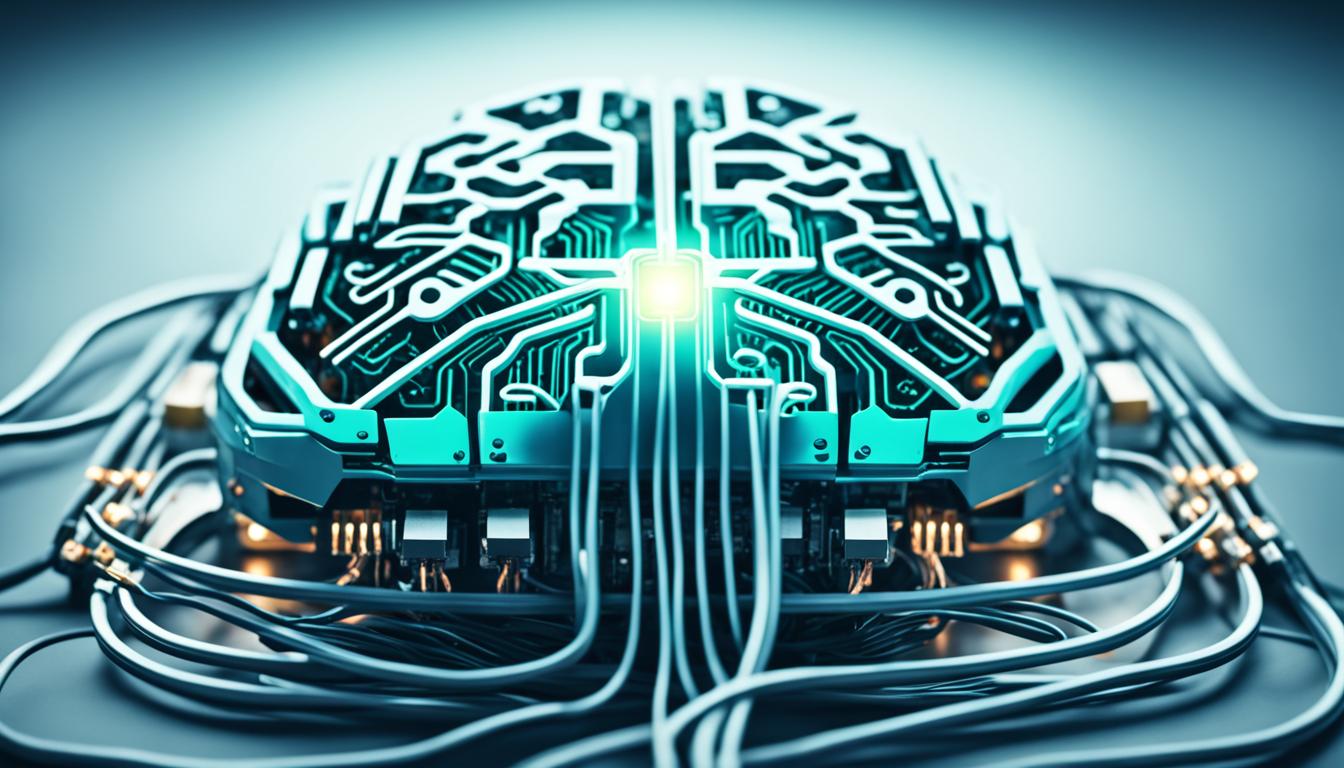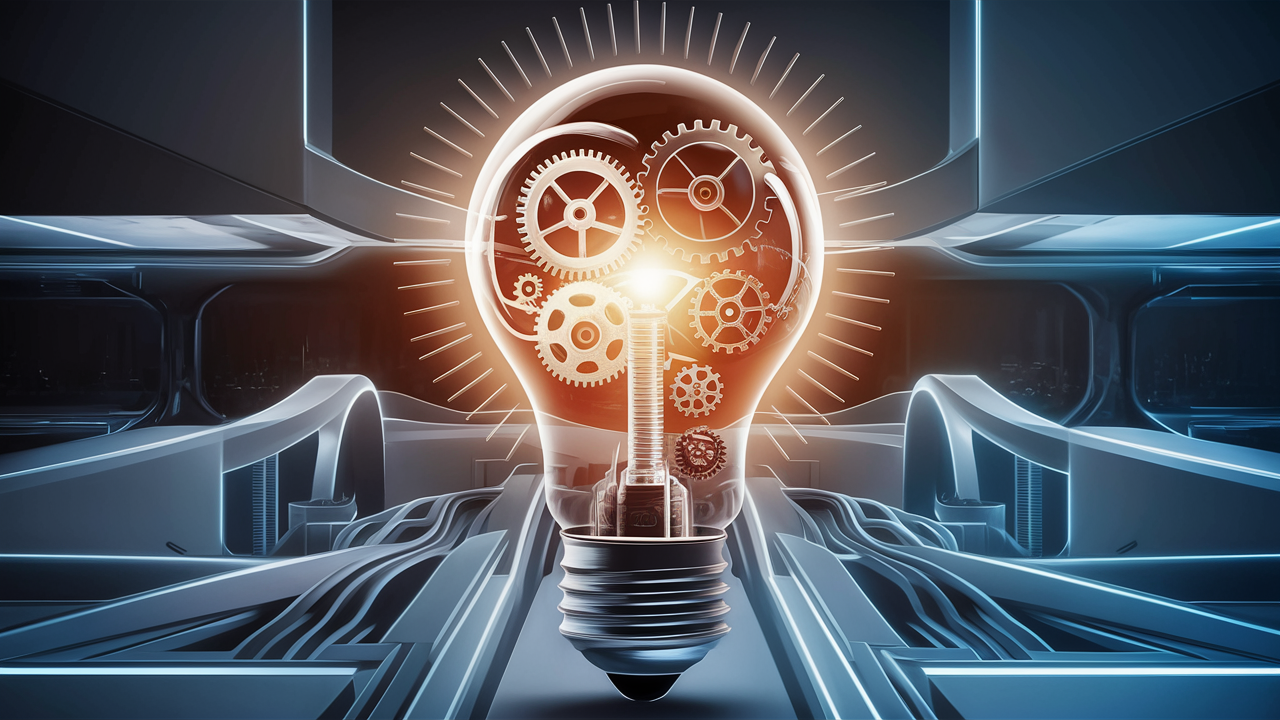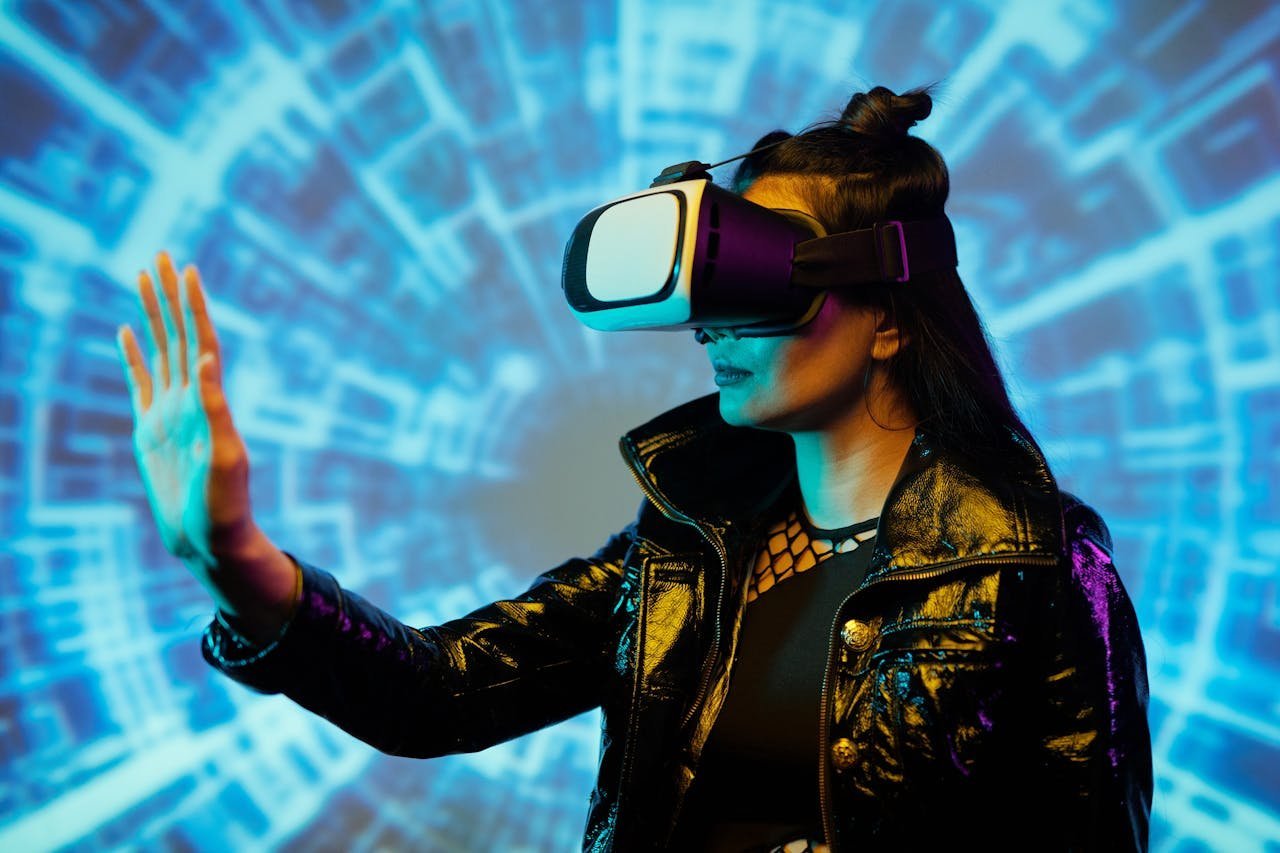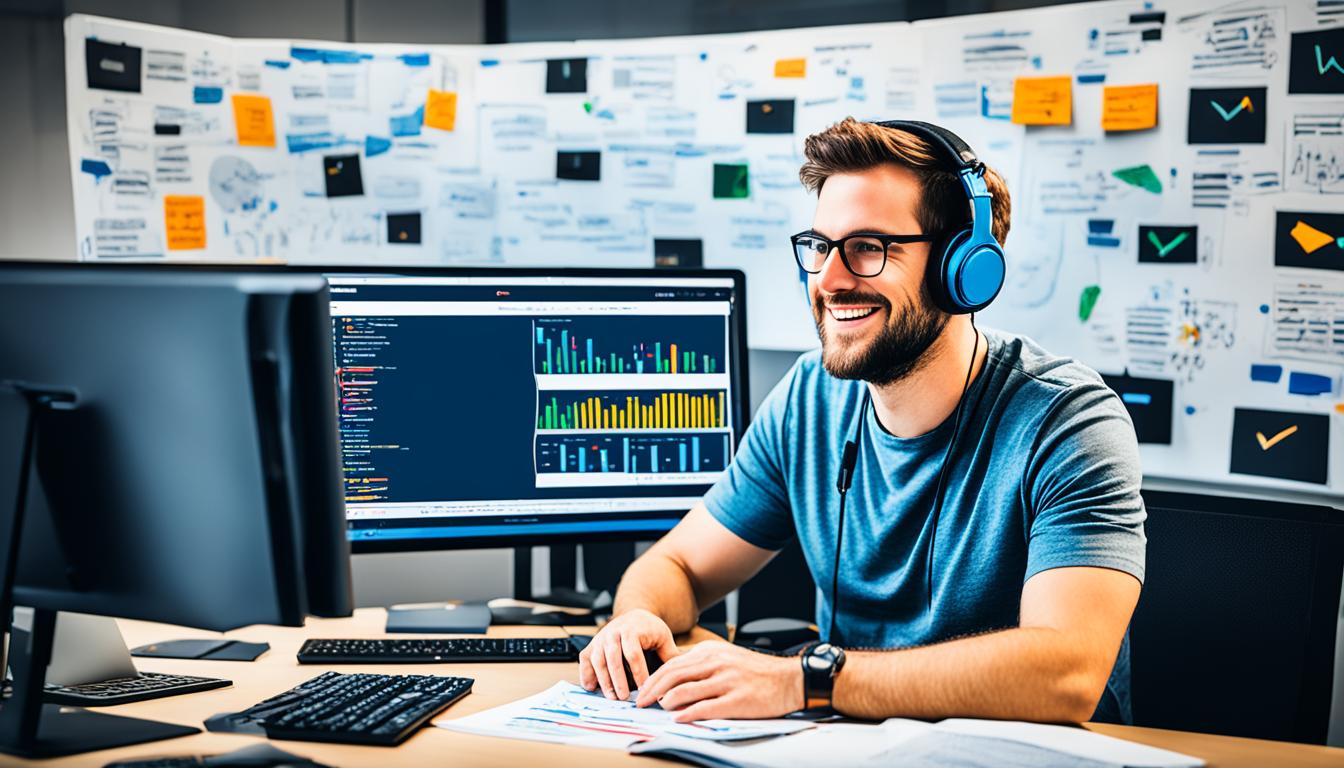Artificial Intelligence (AI) is changing how we live, work, and use technology. It’s important to know what AI is and how it works. This guide will introduce you to Artificial Intelligence in a friendly way.
What is Artificial Intelligence (AI)?
A futuristic robot brain with a glowing circuit board and wires, symbolizing the power and complexity of artificial intelligence.
Key Takeaways
- Artificial Intelligence (AI) is a field of computer science that focuses on developing systems and algorithms that can perform tasks typically requiring human intelligence.
- AI technology is rapidly evolving, with advancements in areas such as machine learning, natural language processing, and computer vision.
- AI has a wide range of applications, from healthcare and transportation to entertainment and cybersecurity.
- While AI offers numerous benefits, it also raises ethical concerns and potential risks that need to be addressed.
- The future of AI holds exciting possibilities, including the emergence of more advanced AI systems and the integration of AI into our daily lives.
Introduction to Artificial Intelligence
Artificial Intelligence (AI) has always fascinated people, from visionaries to the general public. It has seen many important milestones, changing what we think is possible. These milestones have shaped the future of technology.
AI: Redefining the Future
AI started in the 1950s with pioneers like Alan Turing and John McCarthy. Since then, it has grown thanks to better computing power, data handling, and learning algorithms. Now, AI can solve complex problems in many industries.
Historical Milestones in AI Development
AI’s growth has been marked by key events:
- 1956: The Dartmouth Conference introduced the term “Artificial Intelligence,” starting the field.
- 1997: IBM’s Deep Blue beat Garry Kasparov in chess, showing AI’s strategic skills.
- 2011: IBM’s Watson won Jeopardy!, proving AI’s language and information skills.
- 2016: AlphaGo by Google DeepMind beat the Go world champion, a big win for AI.
- 2022: GPT-3 changed natural language processing, opening new AI possibilities.
AI is still growing and will change the future. It will transform industries, solve hard problems, and improve our lives in ways we can’t yet see. The future looks exciting and will likely be transformative.
What is Artificial Intelligence (AI)?
Artificial Intelligence (AI) is changing how we live and work. It lets machines think and act like us, learning, solving problems, and making decisions. This includes machine learning, deep learning, and natural language processing.
AI technology tries to copy how our brains work. It uses smart algorithms and lots of data to understand information, find patterns, and make quick, smart choices. This helps AI solve hard problems and do tasks that humans used to do alone.
The definition of artificial intelligence covers many uses, like virtual assistants and self-driving cars. As AI gets better, it’s changing many industries and making our lives easier.
If you’re curious about AI meaning or the new AI applications changing different areas, it’s key to know how it works. Let’s dive into the exciting world of Artificial Intelligence and see what it can do.
“Artificial intelligence is the future, not the past.” – Tony Fadell, Inventor of the iPod
Types of Artificial Intelligence
Artificial Intelligence (AI) covers a wide range of capabilities and applications. It’s important to know the different types and what they do. Each type has its own special features and uses.
Narrow or Weak AI
Narrow or weak AI is also called Artificial Narrow Intelligence (ANI). It’s made to do one specific task or a few tasks. These systems are super good at what they do, like playing chess, finding medical conditions, or managing supply chains. But, they can’t do tasks outside their main job.
This type of AI is the most common today. It powers many technologies we use every day.
General or Strong AI
General or strong AI is also known as Artificial General Intelligence (AGI). It’s a big goal in AI. This AI would think and learn like a human, solving problems in many areas. Unlike narrow AI, it’s not just for one task.
But, making general AI is hard and still not here. We don’t know when it will be ready.
Knowing the difference between narrow and general AI helps us set realistic goals. It guides how we make AI that can really change our world.
| Narrow or Weak AI | General or Strong AI |
|---|---|
| Designed for specific tasks | Possesses human-like cognitive abilities |
| Highly proficient in designated areas | Capable of learning, reasoning, and solving problems across domains |
| Lacks the ability to adapt to tasks outside its scope | Aims to emulate the versatility and adaptability of the human mind |
| Currently the most prevalent form of AI | Not yet achieved, timeline for realization remains uncertain |
“The future of artificial intelligence holds immense promise, but it’s critical to understand the different types and their capabilities to ensure we harness this technology responsibly and effectively.”
AI Applications and Use Cases
AI has changed the game in tech, making big waves across many fields. It’s now a key player in healthcare, finance, transportation, and entertainment. AI helps solve tough problems, automate tasks, and make better decisions. Let’s dive into some exciting ways AI is changing our lives and work.
Revolutionizing Healthcare
In healthcare, AI is making big moves. AI algorithms analyze medical images, spot early disease signs, and help with treatment plans. AI chatbots also offer virtual health help, making it easier for patients to get info and connect with doctors.
Enhancing Financial Services
Finance has welcomed AI with wide arms. AI finds fraud, improves investment strategies, and automates financial tasks, saving time and money. AI also helps people make smarter money choices with financial advice.
Transforming Transportation
AI is changing how we travel. Self-driving cars make roads safer and smoother, and AI helps manage traffic, cutting down on jams. It’s also boosting logistics and supply chain, making transport more efficient.
Revolutionizing Entertainment
Entertainment is getting a boost from AI too. AI suggests personalized content, making fans happier and more engaged. It’s also creating realistic special effects, automating editing, and even making AI art and music, opening new doors for creativity.
These examples show how AI is reshaping industries and the future. As AI grows, its potential to change and challenge us in many areas is huge. It brings both new chances and big questions for us all.
Create an image showcasing the various applications of AI in different fields, such as healthcare, finance, transportation, and education. Use different colors and visual elements to represent each industry and their respective use cases for AI technology. Make sure to include diverse individuals in the image to convey the inclusive nature of AI and its potential impact on society.
Benefits and Challenges of AI
Artificial Intelligence (AI) is changing the world, offering both great benefits and risks. We need to look closely at its advantages and challenges. This way, we can use its power wisely and deal with its downsides.
Advantages of AI
The benefits of AI are many and wide. AI systems are great at handling lots of data fast, spotting patterns, and making quick decisions. This makes things more efficient, boosts productivity, and helps with making better choices in many fields. For example, AI helps with health advice and financial analysis, making things easier for everyone.
Potential Risks and Concerns
Despite the advantages of AI, there are also challenges and risks. One big worry is that AI might take jobs away from people. Also, AI can be biased and needs to make clear and fair decisions. These are big ethical issues we must think about carefully.
There are also risks of AI like security problems and privacy issues. AI could be used for bad things if not handled right. As AI gets better, we need strong rules and ethical guidelines to use it wisely and fairly.
“As AI becomes more prevalent in our lives, it is essential that we proactively address the challenges and ethical concerns to ensure its responsible and beneficial use.”
We must see both the benefits of AI and the challenges of AI to make the most of it. By finding a balance between new ideas and being responsible, we can make AI a big help in our lives. This balance is key to getting the most out of Artificial Intelligence.
AI and Machine Learning
Artificial Intelligence (AI) is changing fast, thanks to machine learning algorithms and techniques. These systems can learn from data, spot patterns, and make smart choices on their own. They don’t need to be told exactly what to do.
AI and machine learning are great at solving tough problems and opening up new chances in many fields. They help with everything from making recommendations to predicting what will happen next. The uses of AI and machine learning are endless and touch many areas of life.
- Machine Learning Algorithms: These are the core of AI systems. They let machines learn and get better over time. This way, they can make decisions based on data and predict what might happen.
- AI-powered Machine Learning: Putting AI and machine learning together has made smarter systems. These systems can change and get better on their own.
- Machine Learning Applications: Fields like healthcare, finance, and transportation use machine learning applications. They make things run smoother, offer personalized services, and make better choices.
AI and machine learning do more than just make things more efficient. They can spark new ideas, uncover hidden insights, and change how we live and work. As AI grows, machine learning will be key in shaping the future.
“The true power of AI lies in its ability to learn and adapt, constantly improving and expanding its capabilities to solve complex problems.”
Create an image featuring a complex network of wires and circuitry, with sparks flying amidst glowing blue and green lights, symbolizing the intricate workings of artificial intelligence and machine learning. The wires should be arranged in a way that suggests a vast system of interconnecting neurons, with different sections illuminated to highlight the various functions of AI. In the background, show silhouettes of people and objects, indicating how AI is woven into the fabric of our daily lives.
The Future of Artificial Intelligence
Artificial Intelligence (AI) is changing the world in big ways. It’s making industries better, changing how we make decisions, and affecting many parts of our lives. AI is becoming a key part of our future, blending with new technologies and shaping our world.
Emerging AI Trends
AI is getting better at working with other technologies like the Internet of Things (IoT), robotics, and cloud computing. This will lead to smarter, faster, and more adaptable systems that can solve complex problems better. It’s an exciting time for AI.
AI is also playing a bigger role in making decisions. It helps experts in fields like healthcare and finance make better choices. AI will keep helping us make smarter decisions by providing insights from data.
AI will change society in big ways too. It will change how we live, work, and interact with the world. AI will make healthcare more personalized, help with transportation, and improve education.
“The future of AI is not about human vs. machine, but rather human and machine working together to create a better world.”
We need to keep up with AI trends to make sure they’re used for good. We should focus on ethics, responsibility, and making things better for everyone.
Ethics and Responsibility in AI
As Artificial Intelligence (AI) gets more advanced, we must focus on its ethical side. We need to make sure it’s developed and used right. Issues like privacy, bias, transparency, and accountability are big concerns. Experts are trying hard to make sure AI helps people and fits our values.
Data privacy is a big worry with AI. AI systems gather a lot of personal data. We need strong privacy rules to protect our rights and keep our info safe. Groups of regulators and leaders are working on AI privacy rules that let us innovate and stay safe.
AI could also spread or make biases worse. Developers must watch out for biases in their systems. Making AI decisions clear and checking them often helps make sure they’re fair and right for everyone.
AI is becoming more powerful, so we need strong rules to use it right. People who make policies, think deeply about ethics, and work in the industry are coming together. They want to set rules, guidelines, and checks to help use AI safely and protect everyone.
FAQ
What is Artificial Intelligence (AI)?
Artificial Intelligence (AI) is a branch of computer science. It aims to make systems and machines that can do tasks that need human smarts. This includes learning, solving problems, making decisions, and seeing things.
What are the different types of AI?
There are two main kinds of AI. Narrow or Weak AI is made to do certain tasks. General or Strong AI can do many tasks and think like humans.
How does AI work?
AI uses algorithms and machine learning to look at data, find patterns, and decide. This lets AI systems do tasks that needed human smarts before. Like understanding language, seeing images, and predicting things.
What are some real-world applications of AI?
AI is used in many areas, like healthcare, finance, and transport. It helps with virtual assistants, image recognition, spotting fraud, self-driving cars, and making personalized suggestions.
What are the benefits and challenges of AI?
AI makes things more efficient, helps with making decisions, and boosts productivity. But, it can also cause jobs to disappear, show bias, and raise ethical questions about its use.
How is AI related to machine learning?
Machine learning is key to AI. It lets systems learn from data and get better over time without being told how. Many AI tools use machine learning to work.
What is the future of AI?
The future of AI looks bright, with more progress in understanding language, seeing images, and making decisions on its own. New trends include AI combining with other tech, making more decisions, and changing society.
How can AI be developed and used responsibly?
We need to make sure AI is developed and used right. This means looking at privacy, bias, being clear, and being accountable. We also need rules to make sure AI helps people, not just companies.




